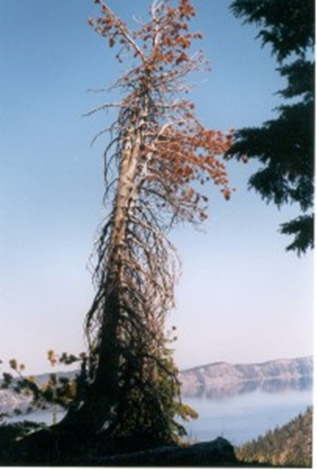
photo by F.T. Campbell
I began studying and writing about the threat to North America’s forests from non-native insects and pathogens in the early 1990s – nearly 30 years ago. I reported my analyses of the evolving threat in the three “Fading Forests” reports – coauthored by Scott Schlarbaum – in 1994, 2003, and 2014. These reports are available here.
So what has changed over those 30 years? What remains the same? Why have both the changes and the stasis occurred? What can we do to fix the gaps, close unaddressed pathways, strengthen flabby policies? I will address these issues in this and following blogs.
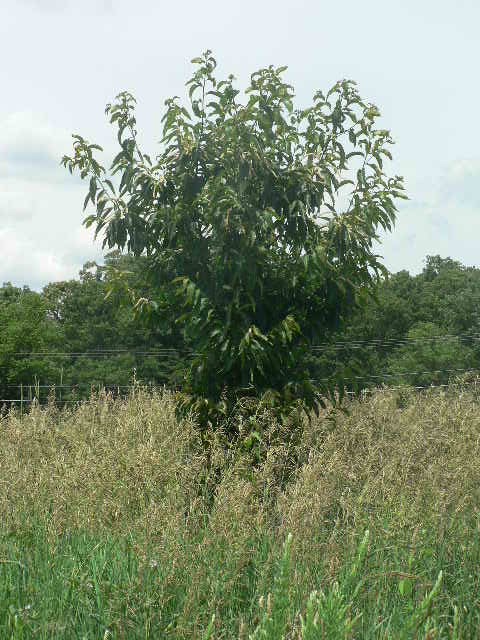
photo by F.T. Campbell
What has changed since the early 1990s:
- Adoption and implementation of significant new international and national regulations and programs aimed at preventing introductions of non-native invasive species.
- Despite the welter of new regulations, an alarming increase in numbers of highly damaging forest pests established in the country. (By my count, about 50 new species have established on the continent, six on Pacific islands; see details below.)
- Alarming spread of established pests to new geographic regions and new hosts (e.g., emerald ash borer in 35 states and 5 provinces; laurel wilt disease across the range of redbay and swamp bay; rapid ‘ōhi‘a death on three of the main Hawaiian islands).
- Introductions via unexpected pathways and vectors far removed from phytosanitary agencies’ usual targets, e.g., ship superstructures, imported steel and stone …
What has remained the same since the early 1990s:
- Inadequate resources provided to response and recovery efforts.
- Available funding focused on only a few of the more than 90 species causing damage.
- Adoption of insufficiently protective regulations that have failed to prevent introduction and spread of tree-killing pests.
- Lengthy delays in implementing programs that tighten controls – another factor in continuing introductions and spread.
- Continued importance of expected pathways – nursery stock and raw wood, especially crates, pallets, and other forms of wood packaging.
- Federal and state agencies still choose not to take action on pests e.g., goldspotted oak borer, polyphagous and Kuroshio shothole borers, beech leaf disease.
- Inadequate coordination despite several efforts to set priorities.
- Spurts of attention by media and political decision-makers, contrasted by lengthy periods of inattention.
- Failure of most stakeholders to support efforts to prevent and respond to introductions of tree-killing pests.
Details: The Situations Then and Now
(Many of the individual species mentioned here are described more fully here. Full citations of sources are at the end of blog.)
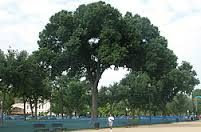
American elm on the National Mall, Washington, D.C.
photo by USDA Agricultural Research Service
In 1993:
- The number of non-native forest pest species established in the U.S. was estimated at between 300 (Millers et al. 1993) and 380 (Mattson et al., 1994; Liebhold et al., 1995) .
- The area suffering the greatest numbers and impacts was the Northeast.
- Several highly damaging pests that had been established for decades, including chestnut blight, white pine blister rust, Port-Orford-cedar root disease, Dutch elm disease, hemlock woolly adelgid, butternut canker, and dogwood anthracnose were receiving some attention but continued to spread.
- USDA Forest Service funding for management of exotic pest infestations was crisis-oriented, with “… priorities … set under political pressures for immediate answers, with too much regard for short-term problems and too little consideration for broader management objectives.” (NAS 1975)
- Since few high-profile pests had been introduced in recent years, APHIS was not actively engaged. In FY92, APHIS spent $20 million on efforts to eradicate the Asian gypsy moth. The narrow focus is illustrated by the fact that in FY93, more than two-thirds of all USDA tree pest control funds were devoted to efforts to suppress or eradicate the European gypsy moth (See FFI).
- Concern about possible new introductions had grown; it focused on proposals to import unprocessed wood from Siberia, New Zealand, and Chile. The USDA Forest Service, academic scientists, and therefore APHIS emphasized the risks of known Asian pests, e.g., Asian gypsy moth, to western coniferous forests (See FFI). While individual scientists had expressed concern about wood packaging material, there was little public discussion of this threat.
- We would learn later that several of the most damaging pests were already present in the country but not yet recognized – Asian longhorned beetle, sudden oak death pathogen, probably emerald ash borer.
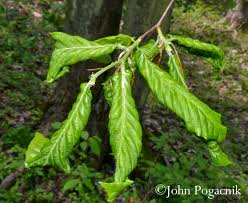
beech leaf disease
photo by John Pogacnik
In 2019:
- Numbers of non-native insects and pathogens attacking trees in North America approach 500 species. (In Fading Forests III, I calculated that by the first decade of the 21st Century, the number had risen to at least 475. Several more have been detected since 2014. More than 181 exotic insects that feed on woody plants had established in Canada. (Source: USDA APHIS. 2000. Wood packaging risk assessment.)
- Of these, 91 are considered “serious” threats (Guo et al. 2019). This estimate excludes pests native to portions of North America that are causing severe damage in naïve hosts – e.g., goldspotted oak borer; pests of palms; and pests attacking trees on U.S. Pacific and Caribbean islands.
- Introductions had continued.
- Between 1980 and 2016, at least 30 non-native species of wood- or bark-boring insects (Scolytinae / Scolytidae) were newly detected in the U.S. (Haack and Rabaglia 2013; Rabaglia et al. 2019). A few of these are highly damaging, e.g. redbay ambrosia beetle, polyphagous and Kuroshio shothole borers.
- In addition to these 30 new pests, other highly damaging tree-killing pests probably introduced since the 1980s include (on the continent):
- Eight Cerambycids such as Asian longhorned beetle (Wu et al. 2017)
- 7 Agrilus, including emerald ash borer and soapberry borer; plus goldspotted oak borer transported from Arizona to California (Digirolomo et al. 2019; R. Haack, pers. comm.)
- Sirex woodwasp
- Pests of palm trees, e.g., red palm mite, red palm weevil, South American palm weevil
- Spotted lanternfly
- Beech leaf disease
- Also not included in the above estimate and lists are tree-killing pests on America’s Pacific Islands :
- ‘ōhi‘a rust
- Cycad scale
- Cycad blue betterfly
- Erythrina gall wasp
- two Ceratocystis pathogens that cause rapid ‘ōhi‘a death
- Coconut rhinoceros beetle
- Authorities also carried out approximately 25 eradication programs targetting introductions of the Asian gypsy moth (USDA Pest Alert Asian Gypsy Moth plus additional outbreaks since 2014).
- Impacts of exacerbated tree mortality rates linked to these introduced pests are seen across wide swaths of the country, and affect widespread species, genera, and families.
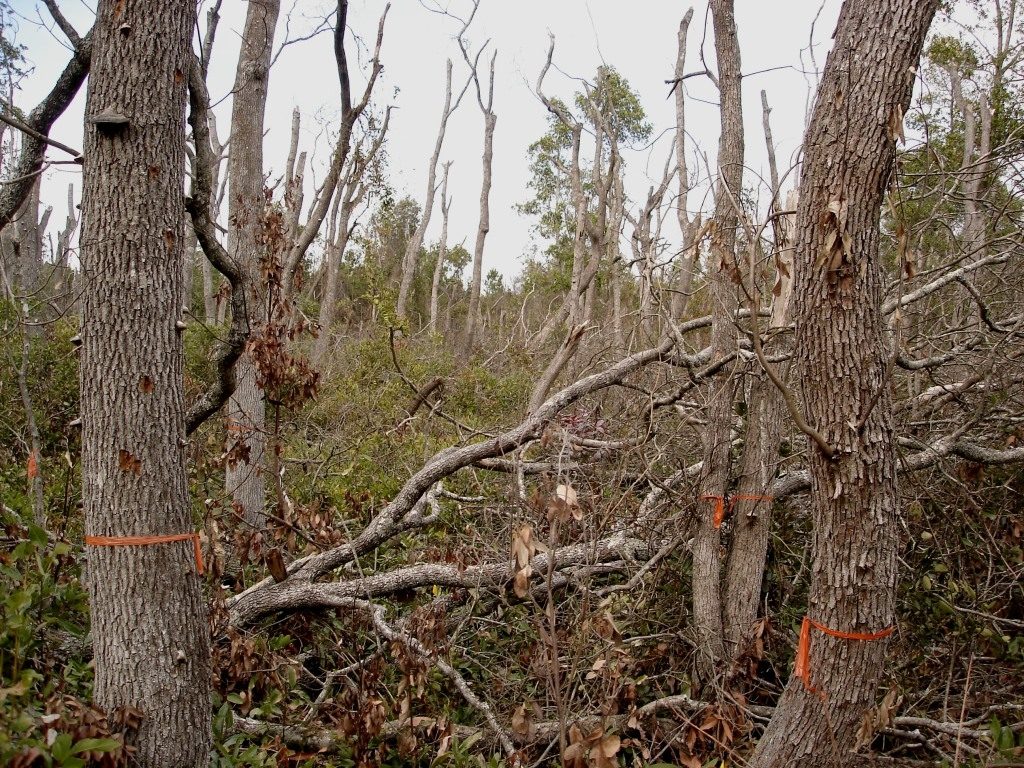
photo by Scott Cameron
I will discuss the risk of continuing new introductions in a separate blog.
Trying to Develop the Big Picture and Set Priorities
In recent years, USDA Forest Service scientists have made several attempts to provide nation-wide assessments of the impact of these pests and criteria for establishing priorities.
The National Insect and Disease Forest Risk Assessment predicted the loss of basal area to various pests over the 15-year time period 2012 – 2027. The assessment predicted the following losses for specific species: 90% for redbay; 60% for whitebark pine; more than 40% for limber pine; 24% for tanoak; 11% for coast live oak; 6% for eastern and Carolina hemlock; 27% for eight species of ash; 20% for American elm; 19% for red oak; 18% for American beech (Krist et al. 2014).
A separate group of scientists found that, nation-wide, non-native forest pests are causing an approximate 5% increase in total mortality by tree volume (Randy Morin at NEFPC). For details on Dr. Morin’s findings, see my blog here.
A third approach to developing a nation-wide picture, Project CAPTURE, (and my blog here) utilized FIA data to develop priorities for conservation action. Fifteen species were placed in the highest priority category, including Florida torreya (Torreya taxifolia), American chestnut and Allegheny and Ozark chinquapins, redbay, five species of ash, two species of hemlock, Port-Orford cedar, tanoak, and butternut (Potter et al. 2019(b).
According to Project CAPTURE, the non-native pests affecting the largest number of hosts are the European gypsy moth, which attacks 65 hosts; and oak wilt (Bretziella fagacearum), which infects 61 hosts. The Asian longhorned beetle attacks 43 hosts (Potter et al. 2019(b).
I note that several other non-native pests also have high numbers of host species. In the Project CAPTURE study, these pests are ranked lower because the project limited its evaluation to the five agents with the greatest effect on any particular host. Thus, of the 18 native tree species that host one or both of the invasive shothole borers and associated Fusarium disease complex (PSHB website), the project included only six. Of the 22 tree species listed by APHIS as hosts of Phytophtora ramorum, the project included 12 (K. Potter, pers. comm. April 17, 2019).
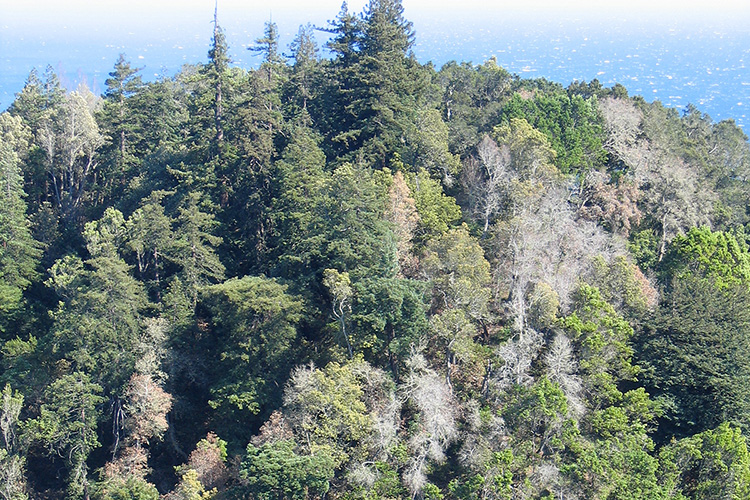
photo by Matteo Garbelotto, University of California Berkeley
More extensive discussions of non-native pests’ impacts are provided in Lovett et al. 2006, Lovett et al. 2016, and Potter et al. 2019. A book-length discussion of invasive species impacts – ranging from feral hogs to invasive plants, is expected in December; look for Poland et al. (in press).
SOURCES
Aukema, J.E., D.G. McCullough, B. Von Holle, A.M. Liebhold, K. Britton, & S.J. Frankel. 2010. Historical Accumulation of Nonindigenous Forest Pests in the Continental United States. Bioscience. December 2010 / Vol. 60 No. 11
Digirolomo, M.F., E. Jendek, V.V. Grebennikov, O. Nakladal. 2019. First North American record of an unnamed West Palaearctic Agrilus (Coleoptera: Buprestidae) infesting European beech (Fagus sylvatica) in New York City, USA. European Journal of Entomology. Eur. J. Entomol. 116: 244-252, 2019
Guo, Q., S. Fei, K.M. Potter, A.M. Liebhold, and J. Wenf. 2019. Tree diversity regulates forest pest invasion. Proceedings of the National Academy of Sciences of the United States of America. www.pnas.org/cgi/doi/10.1073/pnas.1821039116
Haack, R.A. and R.J. Rabaglia. 2013. Exotic Bark and Ambrosia Beetles in the USA: Potential and Current Invaders. CAB International 2013. Potential Invasive Pests of Agricultural Crops (ed. J. Peña)
Krist, F.J. Jr., J.R. Ellenwood, M.E. Woods, A. J. McMahan, J.P. Cowardin, D.E. Ryerson, F.J. Sapio, M.O. Zweifler, S.A. Romero 2014. National Insect and Disease Forest Risk Assessment. United States Department of Agriculture Forest Service Forest Health Technology Enterprise Team FHTET-14-01
Leung, B., M.R. Springborn, J.A. Turner, E.G. Brockerhoff. 2014. Pathway-level risk analysis: the net present value of an invasive species policy in the US. The Ecological Society of America. Frontiers of Ecology.org
Liebhold, A. M., W. L. MacDonald, D. Bergdahl, and V. C. Mastro. 1995. Invasion by exotic forest pests: a threat to forest ecosystems. Forest Sci., Monograph 30. 49 pp.
Lovett, G.M., C.D. Canham, M.A. Arthur, K.C. Weathers, and R.D. Fitzhugh. Forest Ecosystem Responses to Exotic Pests and Pathogens in Eastern North America. BioScience Vol. 56 No. 5 (May 2006)
Lovett, G.M., M. Weiss, A.M. Liebhold, T.P. Holmes, B. Leung, K.F. Lambert, D.A. Orwig, F.T. Campbell, J. Rosenthal, D.G. McCullough, R. Wildova, M.P. Ayres, C.D. Canham, D.R. Foster, SL. Ladeau, and T. Weldy. 2016. NIS forest insects and pathogens in the US: Impacts and policy options. Ecological Applications, 26(5), 2016, pp. 1437–1455
Mattson, W. J., P. Niemela, I. Millers, and Y. Ingauazo. 1994. Immigrant phytophagous insects on woody plants in the United States and Canada: an annotated list. USDA For. Ser. Gen. Tech. Rep. NC-169, 27 pp.
Millers, I. United States Department of Agriculture, Forest Service Entomologist, Forest Health Protection Northeastern Area State and Private Forestry. Durham, NH. Personal communication to F.T. Campbell, 1993.
Morin, R. presentation at Northeastern Forest Pest Council 81st Annual Meeting, March 12 – 14, 2019, West Chester, Pennsylvania
National Academy of Sciences. 1975. Forest Pest Control. Washington, D.C.
Poland, T.M., Patel-Weynand, T., Finch, D., Miniat, C. F., and Lopez, V. (Eds) (2019), Invasive Species in Forests and Grasslands of the United States: A Comprehensive Science Synthesis for the United States Forest Sector. Springer Verlag. (in press).
Polyphagous shothole borer website https://ucanr.edu/sites/pshb/overview/About_PSHB/
Potter, K.M., M.E. Escanferla, R.M. Jetton, and G. Man. 2019. Important Insect and Disease Threats to US Tree Species and Geographic Patterns of Their Potential Impacts. Forests 2019, 10, 304.
Potter, K.M., Escanferla, M.E., Jetton, R.M., Man, G., Crane, B.S. 2019. Prioritizing the conservation needs of US tree spp: Evaluating vulnerability to forest insect and disease threats, Global Ecology and Conservation (2019), doi: https://doi.org/10.1016/
Rabaglia, R.J., A.I. Cognato, E. R. Hoebeke, C.W. Johnson, J.R. LaBonte, M.E. Carter, and J.J. Vlach. 2019. Early Detection and Rapid Response. A Ten-Year Summary of the USDA Forest Service Program of Surveillance for Non-Native Bark and Ambrosia Beetles. American Entomologist Volume 65, Number 1
USDA, Animal and Plant Health Inspection Service. 2014. Asian gypsy moth pest alert https://www.aphis.usda.gov/publications/plant_health/content/printable_version/fs_phasiangm.pdf and pers. comm.
U.S. Department of Agriculture, Animal and Plant Health Inspection Service. 2009. Risk analysis for the movement of wood packaging material (WPM) from Canada into the US.
Wu,Y., N.F. Trepanowski, J.J. Molongoski, P.F. Reagel, S.W. Lingafelter, H. Nadel1, S.W. Myers & A.M. Ray. 2017. Identification of wood-boring beetles (Cerambycidae and Buprestidae) intercepted in trade-associated solid wood packaging material using DNA barcoding and morphology Scientific Reports 7:40316